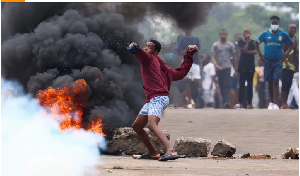In Northern Ghana, the White Volta River is about four times wider than it is normally. Two farmers from Kpasenkpe community sit on a small pirogue watching the river that has inundated their maize fields, which were situated on its banks. Here, around 400 km from the capital Accra, torrential rains started mid August.
"I lost everything, all my crops are destroyed. I had one hectare of maize and three hectares of grains," said Daniel Sebiyam, a farmer from Kpasenkpe.
Around 3,000 people live in the community of Kpasenkpe. The crops growing in their fields - maize, rice, beans, soya beans and millet - were all washed away in the floods.
Ghana Red Cross Society has been on hand to help people since the beginning of the floods. Four hundred Red Cross volunteers have been mobilized in the affected area to assist the victims, provide first aid and health education. A Regional Disaster Response Team (RDRT) has visited communities in order to identify the worst affected people and get a better idea of the items most needed by families.
Agambire Elishna, a Red Cross volunteer, has helped to register farmers to find out about their situations. "People are in urgent need of food. They are desperate and don't know what to do," he said.
The weather conditions have been extremely difficult for the Northern and Upper East regions in Ghana this year. First, there was drought for months and farmers were praying for rain. Then, the heaviest rains fell between 24-29 August, and it continued to rain day and night for about three weeks.
The situation was aggravated when neighbouring Burkina Faso opened a flood gate of the Bagre dam, releasing an enormous amount of water into the White Volta River that flows into Ghana.
"In April, I lost my crops because there was no water but I planted again. Now I've lost the replanted crops in the floods. So there's nothing stored either," said Nelson T. Ndima, who has a wife and six children.
The affected regions are known as the food basket of Ghana. The Northern region produces 40 per cent of the rice used in the county, and the Upper East has the highest production of yam in the country.
A six-member field assessment and coordination team (FACT) from the International Federation of Red Cross and Red Crescent Societies arrived at Tamale, Northern Ghana, on Saturday. During the coming days, the FACT team will join Ghana Red Cross volunteers in visiting 200 more households in the affected districts in order to have a more precise picture of the disaster.
"We haven't been able to access all communities yet because of destroyed roads, broken bridges and the remoteness of the communities," said Benonita Bismark, head of operations at Ghana Red Cross.
Although the water level in the flood zones dramatically dropped last week, the health situation remains difficult. People suffer from diarrhoea, malaria and snake bites. Health centres are difficult to reach because of destroyed roads and there is a shortage of adequate medicines and clean water.
An invasion of black flies has also caused problems among the population. In Kpasenkpe, people have been sent to hospital because of blurred vision and skin problems caused by the black flies.
"Now the amount of black flies has diminished because the government sprayed the area last week," said Mary Azindow, a mother of nine children.
At least the Kpasenkpe residents have been able to save their houses, as these have been built on ground higher than the farm land. But in many parts of the Upper East region people lost not only their crops but also their homes - and have had to seek shelter in schools and churches.
On September 20, the International Federation launched a joint emergency appeal for Ghana and Togo for 2.5 million Swiss francs (US$ 2.1million, €1.5 million) to help 82,000 flood victims during the coming six months.
Regional News of Tuesday, 25 September 2007
Source: International Federation of Red Cross and Red Crescent Societies (IFRC) - Switzerland
Northern Ghana in urgent need of food
Business
















